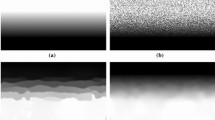Abstract
In this paper, we present a new model of nonlinear diffusion arising in image processing field based on the Perona–Malik equation which we call the bivariate Perona–Malik model. The aim of this model is to remove image noise while preserving edges, boundaries, and textures. To solve this model we use a new algorithm based on mixed finite element method. In this context we prove mathematically the existence and uniqueness of the solution of the proposed model in a well chosen space. At last, we present the experimental results in 2D and 3D images filtering, which demonstrate the efficiency and effectiveness of our algorithm and finally, we compare it with other well known methods such as the finite difference method presented by Perona et al. (IEEE Trans Pattern Anal Mach Intell 12:629–639, 1990), the finite element method and the finite volume method studied by Handlovičová et al. (J Vis Commun Image Represent 13:217–237, 2002).
















Similar content being viewed by others
References
Perona, P., & Malik, J. (1990). Scale space and edge detection using anisotropic diffusion. IEEE Transactions on Pattern Analysis and Machine Intelligence, 12, 629–639.
Catte, F., Lions, P. L., Morel, J. M., & Coll, T. (1992). Image selective smoothing and edge detection by nonlinear diffusion. SIAM Journal on Numerical Analysis, 29, 182–193.
Handlovicova, A., Mikula, K., & Sgallari, F. (2002). Variational numerical methods for solving nonlinear diffusion equations arising in image processing. Journal of Visual Communication and Image Representation, 13, 217–237.
Alvarez, L., Lions, P. L., & Morel, J. M. (1992). Image selective smoothing and edge detection by nonlinear diffusion II, SIAM. Journal of Numerical Analysis, 29, 845–866.
Brezzi, E., & Fortin, M. (1991). Mixed and hybrid finite element methods. New York: Springer.
Stenberg, R. (1990). A technique for analysing finite element methods for viscous incompressible flow. International Journal for Numerical Methods in Fluids, 11, 935–948.
Aboulaicha, R., Meskine, D., & Souissi, A. (2008). New diffusion models in image processing. Computers and Mathematics with Applications, 56, 874–882.
Mikula, K., & Ramarosy, N. (2001). Semi-implicit finite volume scheme for solving nonlinear diffusion equations in image processing. Numerische Mathematik, 89, 561–590.
Alvarez, L., & Morel, J. M. (1994). Formalization and computational aspects of image analysis. Acta Numerica, 3, 1–59.
Preusser, T., & Rumpf, M. (1999). An adaptive finite element method for large scale image processing. In M. Nielsen, P. Johansen, O. F. Olsen, & J. Weickert (Eds.), Proceedings of ScaleSpace-99 (pp. 223–234). Berlin: Springer.
Osher, S., & Sethian, J. (1988). Front propagating with curvature dependent speed: Algorithms based on the Hamilton–Jacobi formulation. Journal of Computational Physics, 79, 12–49.
Sethian, J. A. (1990). Numerical algotithm for propagating interfaces: Hamilton–Jacobi equations and conservation laws. Journal of Differential Geometry, 31, 131–161.
Dziuk, G. (1994). Convergence of a semidiscrete scheme for the curve shortening flow. Mathematical Models and Methods in Applied Sciences, 4, 589–606.
Dziuk, G. (1991). Algorithm for evolutionary surfaces. Numerische Mathematik, 58, 603–611.
Sapiro, G., & Tannenbaum, A. (1994). On affine plane curve evolution. Journal of Functional Analysis, 119, 79–120.
Walkington, N. J. (1996). Algorithms for computing motion by mean curvature, SIAM. Journal of Numerical Analysis, 33, 2215–2238.
Brezzi, F., & Falk, R. (1991). Stability of higher order Taylor-Hood methods. SIAM Journal on Numerical Analysis, 28(3), 581–590.
Brenner, S. C., & Scott, L. R. (2002). The mathematical theory of finite element methods, of Texts in Applied Mathematics (2nd ed., p. 15). New York: Springer.
Wieners, C. (2003). Taylor-Hood elements in 3D, analysis and simulation of multifield problems (pp. 189–196). Berlin, Heidelberg: Springer.
Handlovičová, A., Mikula, K., & Sarti, A. (1999). Numerical solution of parabolic equations related to level set formulation of mean curvature flow. Computing and Visualization in Science, 1, 179–182.
Kačur, J., & Mikula, K. (1995). Solution of nonlinear diffusion appearing in image smoothing and edge detection. Applied Numerical Mathematics, 17, 47–59.
Eymard, R., Gallouet, T., & Herbin, R. (2000). The finite volume method. In P. Ciarlet & P. L. Lions (Eds.), Handbook for numerical analysis (Vol. 7, pp. 715–1022). Amsterdam: Elsevier.
Bansch, E., & Mikula, K. (1999). Adaptivity in 3D image processing, Preprint 99–14. Zentrum fur Technomathematik: Universitat Bremen.
Sarti, A., Mikula, K., & Sgallari, F. (1999). Nonlinear multiscale analysis of 3D echocardiographic sequences. IEEE Transactions on Medical Imaging, 18, 453–466.
John, F. (1991). Partial differential equations (4th edn). Springer. ISBN 978-0-387-90609-6.
Farhloul, M., & Fortin, M. (1993). A new mixed finite element for the stokes and elasticity problems. SIAM Journal on Numerical Analysis, 30(4), 971.
Author information
Authors and Affiliations
Corresponding author
Rights and permissions
About this article
Cite this article
Hjouji, A., Jourhmane, M., EL-Mekkaoui, J. et al. Mixed Finite Element Approximation for Bivariate Perona–Malik Model Arising in 2D and 3D Image Denoising. 3D Res 9, 36 (2018). https://doi.org/10.1007/s13319-018-0187-6
Received:
Revised:
Accepted:
Published:
DOI: https://doi.org/10.1007/s13319-018-0187-6




